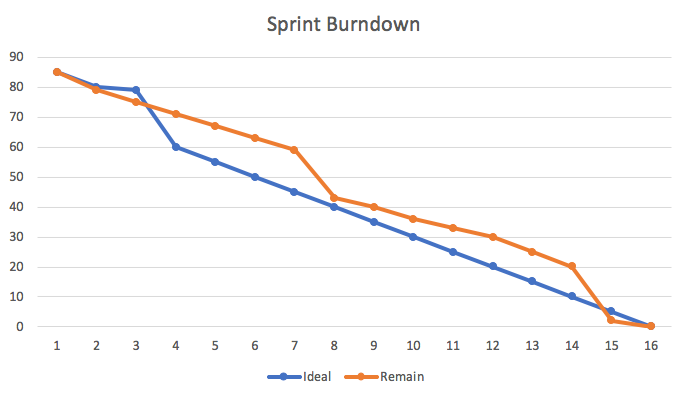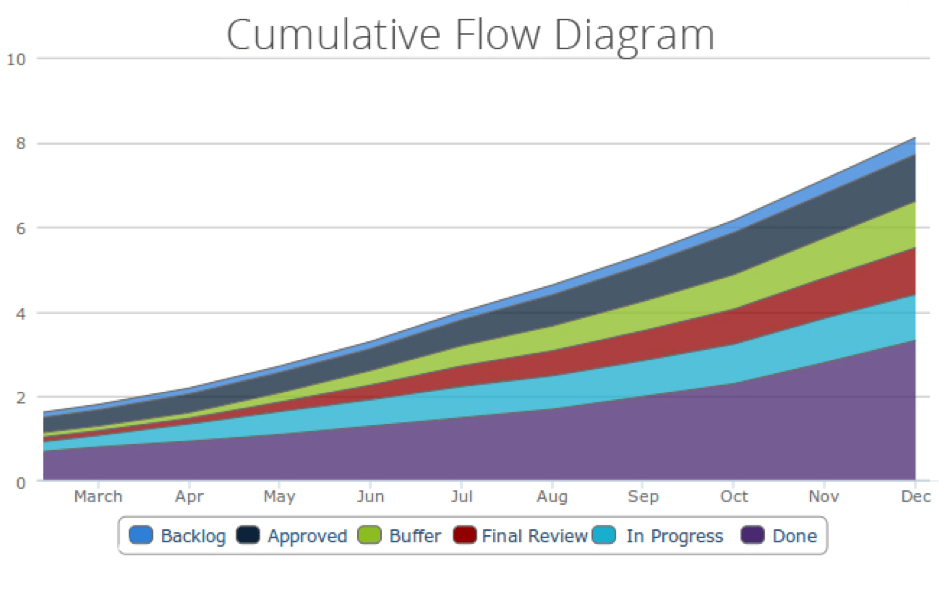Top useful Agile Metrics for measuring the development process

Agile metrics – a common measurement term which is used to evaluate the efficiency of the agile development process, whose main target is how the created value affects customers. Therefore, the agile metrics helps the manager to keep track the team’s productivity.
Agile metrics in action: Measuring progress and productivity
Continuous improvement (CI) underpins the entire agile paradigm. However, this is not something that can be imposed on teams. It must originate within. In a nutshell, self-improvement (SI) is required. As a result, it is acceptable to claim that CI is not conceivable without SI.
Agile metrics emphasize the importance of immediate delivery. However, in this circumstance, SI should not be overlooked. Teams that practice SI outperform those that do not. Having a sustainable and successful SI, on the other hand, is no easy task. It is a long-term process that necessitates a management framework. Agile metrics help SI by tracking software quality and team performance. In certain ways, these measures have a direct impact on CI.
Aside from increasing continuity, providing a high-quality product is an essential component of agile. However, finding a happy medium between the two can be difficult. This necessitates the development of agile metrics against which teams can track their success. Overall, agile metrics assist teams in becoming self-managing. They also assist businesses in providing value. Simultaneously, CI becomes a natural part of the workflow.
What’s the importance of Agile delivery metrics?
Agile metrics are significant because they enable teams and organizations to track and report on the development and success of their Agile projects. These metrics assist teams in identifying areas for improvement, tracking the performance of Agile techniques, and making educated decisions about how to optimize their processes.
Using Agile metrics, teams may gain a better insight into the value they provide to clients, enhance delivery speed, and improve product quality. Overall, Agile metrics enable teams to continuously improve and provide better results.
What characteristics make agile metrics powerful in an Agile Environment?
In an Agile environment, the effectiveness of metrics is of the utmost importance, as they serve as an indispensable instrument for teams to facilitate learning and improve processes. Metrics with particular attributes are instrumental in fostering constructive development within Agile teams.
These characteristics make agile metrics effective in an agile environment:
Relevant
Agile metrics should be pertinent to the team’s objectives and aims. They should be aligned with the project’s vision and aid in measuring progress toward its achievement.
Actionable
Agile metrics should be actionable, providing the team with insights that can be used to enhance performance or modify the approach.
Timely
Agile metrics should be expeditious, which means that they should be updated frequently and in real time so that the team can react swiftly to changes in project direction or performance.
Accurate
Agile metrics should be accurate, which means they should be derived from dependable data and calculated using consistent methods.
Transparency
Agile metrics are transparent and available to all team members. This facilitates open communication and collaboration, both of which are essential for agile development.
Also read: System Development Life Cycle Guideline
Defining the types of Agile metrics
The agile metrics are divided into three types: Lean metrics, Kaban metrics, and Scrum metrics.
Lean metrics
Like lean manufacturing, lean metrics focus on optimizing the working process and bring value to the end users. Lead time and Cycle time are two common metrics in this group.
Kaban metrics
Kaban is the borrowed word from Japanese, and it describes the main objectives in workflow, organizing and prioritizing work and completed it, which use a cumulative flow as a common one.
Scrum metrics
Scrum metrics, which is familiar in the Scrum method, which usually use burndown chart and team velocity metrics to measure the delivery of software to customers.
Top powerful Agile Metrics that matter for success
In this post, I divide the metrics into four parts: Software quality metrics, team productivity metrics, project metrics, and teamwork metrics.
1. Software quality metrics
Like its name, this group includes the metrics to evaluate the quality of the software built by your team and check if it can bring the value to the end users, and this one includes Escaped Defects, Failed Deployments and NPS (Net Promoter Score).
Escaped defects
With this metrics, you can list down all the bugs after releasing an app, which helps the developer team has an overview of the qualified features of an app to make sure the quality of the released app.
Failed deployments
Using Failed deployments, managers can manage the number of deployments to test and build the production environment. Therefore, they can make the decision if the software product gets the certificate of quality.
NPS (Net promoter score)
This metric evaluates the customers’ satisfaction, which helps the business owner predicts if the new software product may follow the current customers’ trend or not, as well as help the managers to build the suitable plan to improve products before releasing.
2. Team productivity metrics
This group of metrics are used to measure the team productivity in finishing a task in a project, which may help the manager check the team members’ ability and understand the strength and weakness of each one. Therefore, the manager is able to predict the working time required to finish a project.
Lead time
Lead time stores and help you control the whole process from the backlog to the release stage. The low lead time means the good development process. This metric allows a manager to get an overview of development efforts.
Cycle time
Cycle time or Control Chart helps you clarify the average speed required to fulfil a project. The shorter cycle time is, the more effective your team are. Additionally, when the manager gets the consistent cycle time of a team, he/she can plan for the future working plan. This also helps the manager to quickly determine the stuck issues the agile software development process.
Sprint burndown
Preparing for a sprint, the IT team may build a predicted plan and forecast the amount of work they have to work to achieve the goals. This one is called the sprint burndown report, which uses a visual chart to check and follow each phase. By doing this, the whole team can make sure if they finish the task as the plan or not. Furthermore, this chart will help team leader evaluates the strength and weakness of team members, as well as a better plan for the next projects.

Epic and release burndown
Visualizing as charts, the epic and release burndown allows checking the larger view of the working process than sprint burndown. This one helps to manage the “over scope” or the added requirements after the project starts, also to make sure the productivity of the team is stable.
Velocity
Using velocity, a manager can evaluate the average quantity of completed sprints, which can be used to forecast and build the plan for the upcoming projects. This helps the manager to easily measure and quickly check the result. There are many factors can influence the productivity, it is necessary tocheck the changes of team’s velocity over time.

3. General project metrics
To have an overall idea and information of a project as well as avoid the all unexpected issues happen, the general project metrics may be a powerful assistant for the manager.
Cumulative flow
Considered as the most powerful agile project metrics for Kanban, Cumulative flow allows a manager to get the overview of the task every sprint. Shown in a chart, the manager can easily follow and control the whole process while determining immediately the bottlenecks.

Code Coverage
If you need a metric to manage the testing productivity, Code Coverage will be your solution. Code Coverage calculates the percentage of code covered by unit tests with a raw visualization, which can be calculated automatically as part of each sprint as well as by quantity of methods, statements, branches, conditions comprising the unit testing suite.
4. Team performance/wellbeing agile metrics
Besides considering the productivity of a team, well-being also plays a crucial role. Based on these metrics, a manager can send encouragement to the team members at the right time to promote members’ passion.
Happiness
It’s not easy to get the flow-chart of members’ feeling, therefore, the best solution is directly asking all the team member about their happiness while working. These following list of questions of Christiaan Verwijs – the psychologist may help you while asking your team members
– Can you share with me how happy do you feel with your company?
– What feels best right now?
– What feels worst right now?
– What to do to increase your happiness?
Team morale
Another way, you can use team morale to mention the feelings of other members instead of Happiness. Because happiness sometimes is immediate feelings, and may not be useful to solve the roots of the problems. By rating these statements, team morale can be shown clearly:
– I was born for this team
– I like my work with the team
– I feel encouraged and proud of the work I do for my team
– I feel my work is meaningful
By asking the specific information, you can get the idea of the team morale to choose the most fitting of these agile performance metrics, and have the strategic plan to promote the team member performance.
By dividing into four main sectors, the blog mentioned the top useful metrics for your agile projects. Of course, in each specific case, people can have their own choice to effectively apply the metrics, the team member and the working style of the team. Therefore, you should make sure to get all the information before making the final decision.
Power of Agile Metrics: Top 10 FAQs Answered
How can Agile teams use metrics to enhance their performance and identify improvement opportunities?
By monitoring and analyzing data related to their project progress, team productivity, and customer satisfaction, Agile teams can use metrics to improve their performance and identify inefficiencies, bottlenecks, and areas for improvement. This allows them to continuously optimize their performance and provide customers with greater value.
How do Agile metrics enable stakeholders to monitor progress and make informed resource allocation and project priority decisions?
Agile metrics provide stakeholders with quantitative and objective data regarding the project’s progress and performance. Agile metrics assist stakeholders in monitoring progress, identifying areas for enhancement, and making informed decisions regarding resource allocation and project priorities.
By analyzing these metrics, stakeholders can determine whether or not the project is on course to meet its objectives, identify potential risks or delays, and adjust resource allocation and prioritization accordingly. This ensures that resources are utilized effectively and that project priorities align with the enterprise’s overall goals.
What role do Agile metrics serve in fostering an organization’s culture of continuous improvement and innovation?
Agile metrics play a crucial role in nurturing a culture of continuous improvement and innovation within an organization by providing feedback on the performance of the development team and the efficacy of the Agile processes.
Teams can use metrics to improve their work quality and speed by monitoring cycle time, lead time, throughput, work in progress, work item age, flow efficiency, and blocked time.
This encourages a culture of experimentation and empowers teams to innovate and deliver consumer value more effectively and efficiently. Teams can also foster transparency, collaboration, and a shared commitment to continuous improvement by sharing and discussing metrics openly with stakeholders.
Adamo Software: Custom Software Development Company
As a leading custom software development company in Vietnam, Adamo Software specializes in building bespoke software solutions in various aspects including education, healthcare, food and beverage, and fintech services, etc.
If you are looking for a custom software development company that can build bespoke software solutions, Adamo is here to help.











